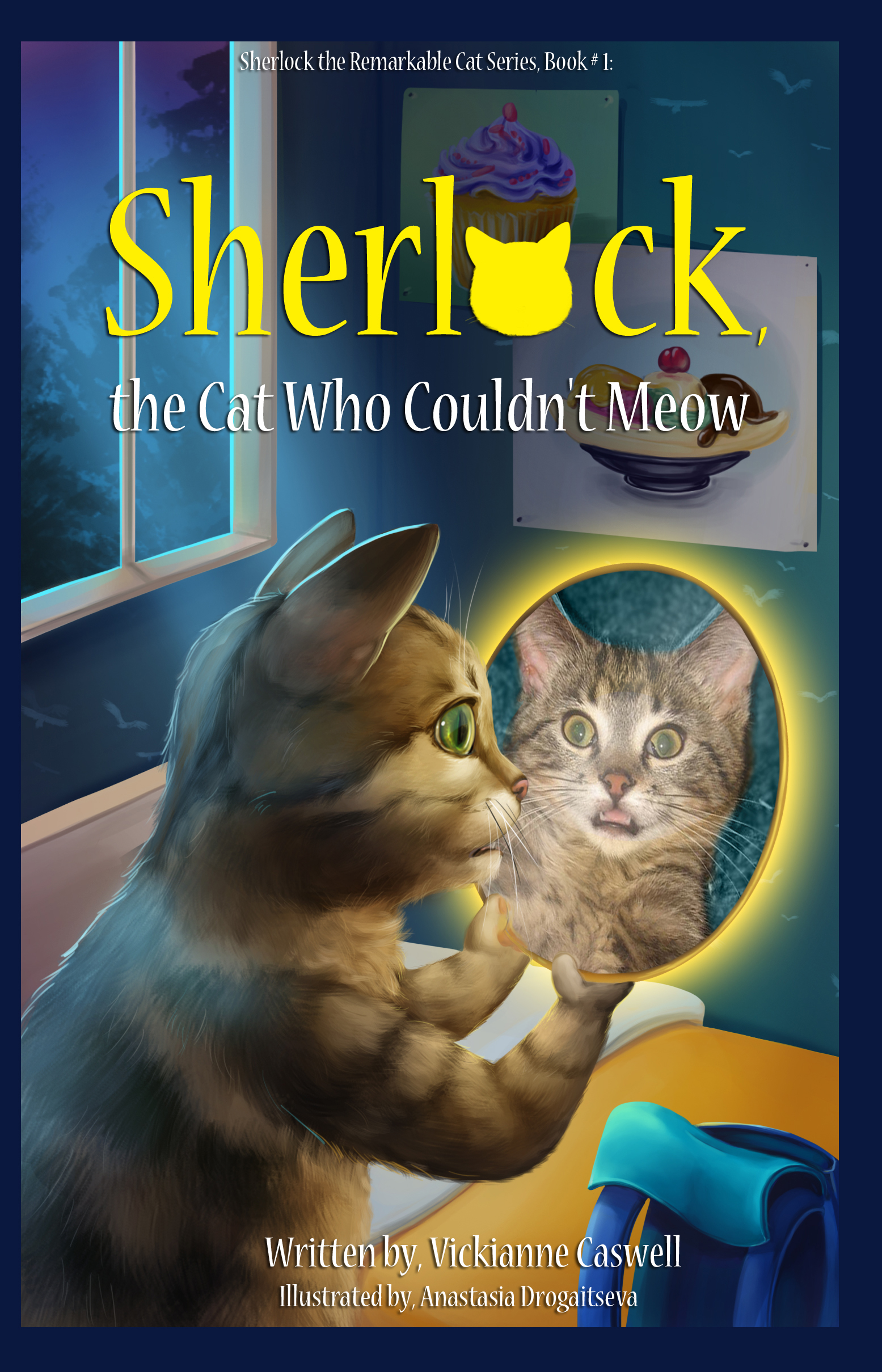Interview with Children's Book Author Sandra Bennett
This week I had the amazing opportunity to be interviewed by Children's Author David Chuka on his blog. Below are my responses to his questions. Read on and learn a little more about my life, my writing and my love of literacy. Interview with Children's Book Author Sandra Bennett.
Emmy Gatrell, a Mother and Author With a Heart for Writing
In our "Second Pay it forward" interview Emmy Gatrell talks about the importance of doing things in life that make you happy. It is important to find and do something you are passionate about and if you can make it your life's work, than even better. My writing for children brings me great joy and if it puts a smile on the face of even one child, then I have been successful. I hope you enjoy reading this interview from this new author, I certianly did. :)
The Awesome Value of Picture Books
When you think of picture books, what are some of the great memories that come to your mind? Snuggling with grandma? Daddy'd tender voice as he read a bedtime story to you? Perhaps laughing with Mum as she read your favourite story but skipped a page hoping you wouldn't notice, (but of course you did, you knew every word by heart).
Every child has a favourite. One that they want read to them night after night. Kept under their pillow or hidden in reach under their bed.
My all time favourite is "Diary of a Wombat" by Jackie French 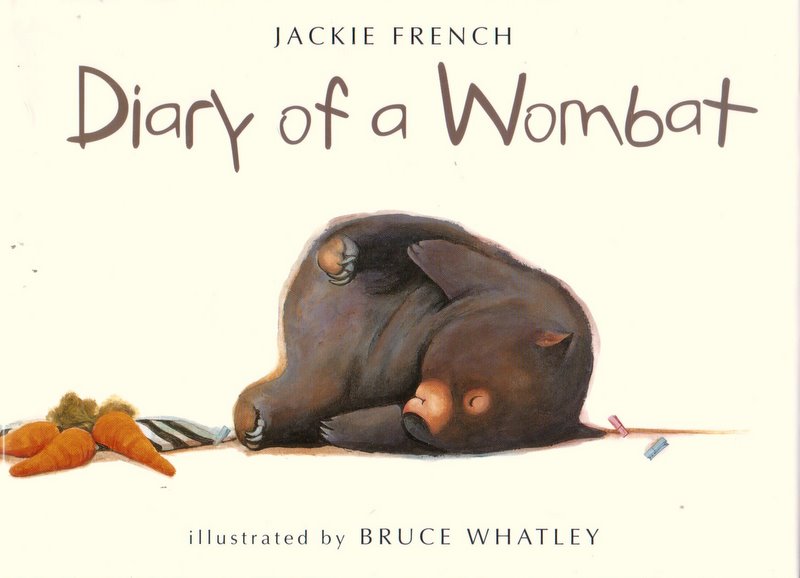 (I've mentioned it in my blogs before). I've read it over and over to so many children during my teaching career, unfortunately I think I've lost my copy in a classroom somewhere and it was personally autographed by Jackie too! I do however still have "Christmas Wombat"
(I've mentioned it in my blogs before). I've read it over and over to so many children during my teaching career, unfortunately I think I've lost my copy in a classroom somewhere and it was personally autographed by Jackie too! I do however still have "Christmas Wombat" 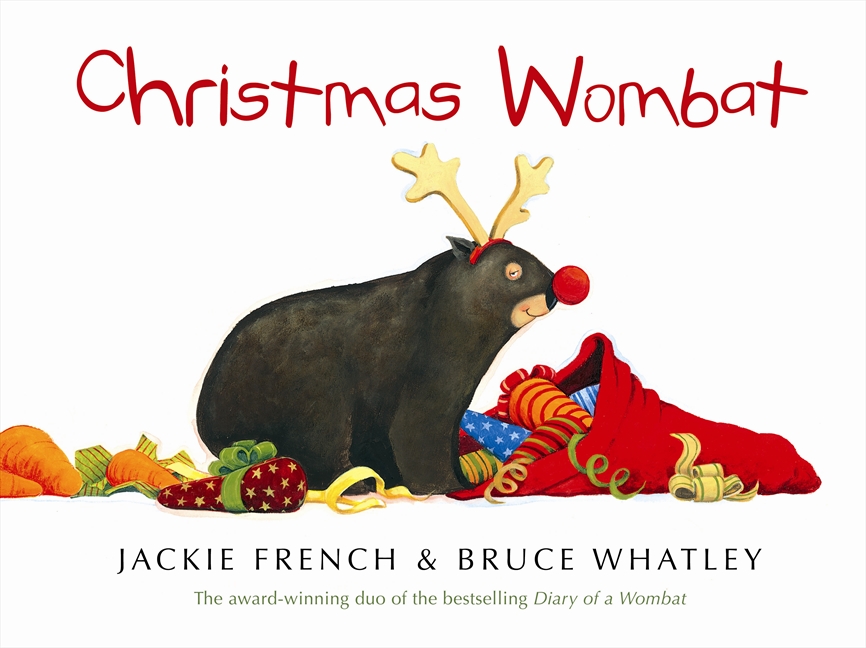 and "Baby Wombat's Week"
and "Baby Wombat's Week" 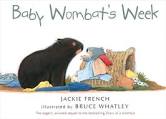 so I am lucky to be able to re-read these whenever I like. As I guess you can see, I rather have a fondness for wombats. They are Australia's unsung heroes, cute and cuddley yet almost forgotten due to the popularity of koalas and kangaroos. Thanks to Jackie French and her wonderful tales wombats are finally getting the recognition they so rightfully deserve, but I digress.
so I am lucky to be able to re-read these whenever I like. As I guess you can see, I rather have a fondness for wombats. They are Australia's unsung heroes, cute and cuddley yet almost forgotten due to the popularity of koalas and kangaroos. Thanks to Jackie French and her wonderful tales wombats are finally getting the recognition they so rightfully deserve, but I digress.
Picture books are our introduction into the wonderful world of imagination and reading. We learn so much more than you might initially think from them.
From the first time we hold a picture book in our hands we begin the early stages of reading. We immediately learn the correct way to hold a book to be able to read it up the right way and from the front to the back. As we listen to an adult read the few words on each page we see to read from left to right. We see the shape of sentences and listen to the sounds of the written language. We also unknowingly begin to learn the fundamental structure of sentence building as well as the more complicated structure of the spoken language itself as we listen to someone read to us over and over again.
We learn that marvelous stories can be told on the pages of books and that we can explore all sorts of magical and mystical worlds through words and pictures.
We also come to realise that the story can be told through the amazing illustrations making it possible to understand the story without reading the words. This then helps in the following stages of learning to read as we search the pictures for cues to help with words by looking at expressions, body language or other clues that might be in the images. For example in "Christmas Wombat" the text talks about the strange creatures that are eating the wombats carrots, but by looking at the illustrations it is clear the creatures are in fact Santa's reindeer.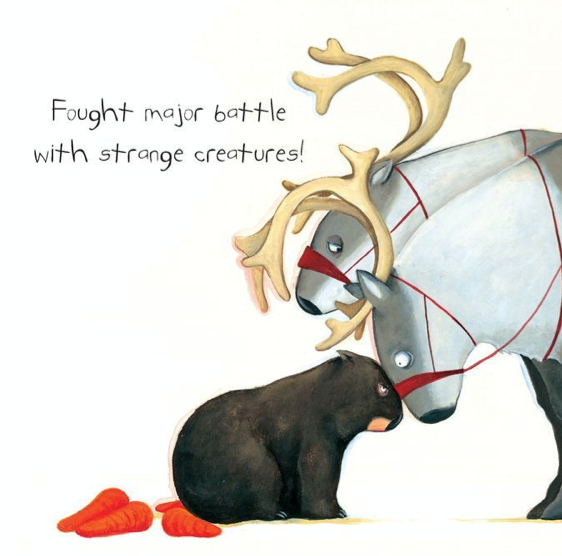
Often a joke or a visual hint may be in the illustration that may not be obvious in the written word demonstrating the visual impact the pictures can have on the story. In "Baby Wombat's week" the wombat is searching for a new bigger home, the illustrations show us some of the places he considers, such as the toddlers sandpit, the garbage bin and a washing basket.
Of course the key to successful learning to read is as much in the conversation that develops about what happens in the story in as much as reading the text or looking at the pictures. A picture is after all worth a thousand words, and a good illustration can tell an incredible story in its own right. Picture books can help to stimulate discussions between parents and children where as more complicated text may reduce the need for that dialogue unless the parent is proactive.
Picture books come in all shapes and sizes but some of the best are the biggest, brightest and most colourful. They stimulate the imagination and are family inclusive. Everyone can snuggle behind a big picture book and easily read together. Why not pop on down to your local library today and see what amazing adventures await you and your family amongst the pages of a big picture book.
As always, have fun reading. :)
Dr Seuss to the rescue
I've posted several quotes from Dr Seuss on my facebook page over the years as I believe many of them are quite insightful. Generations of children have now grown up reading this clever dialogue and enjoying the delightful illustrations. Here in one wonderful place is a list of 30 of his best quotes to sit and ponder. They may even take you back to your childhood and entice you to re-read an old favourite to yourself or someone smaller. As always, have fun reading. :)
Meet the Author: Theresa Jenner Garrido
A great first interview to begin our series of "Pay it Forward Author Interviews." Jessica has asked some insightful questions into the life and mind of an accomplished author who has successfully published several stories. Enter into the world of Theresa Jenner Garrido and discover her passion for writing mystery and intrigue.
A Purrfect Tale of Love and Differences.
"Learn to love your differences because they are a part of who you are. They make you purrfect!"
"Sherlock, the Cat Who Couldn't Meow" is the latest children's book released by Vickianne Caswell, cover art design by Anastasia Drogaitseva. Where Vickianne's book series to date have been picture books for pre-schoolers and perhaps the beginning school years, (please see my previous reviews http://sandrabennettauthor.com/2013/12/03/another-two-furry-cute-tales-in-time-for-christmas/, http://sandrabennettauthor.com/2013/06/11/hop-on-into-two-furry-cute-reads/ ) this is her first venture into short chapter books for 6-10 year olds.
Vickianne has written another winner. She has written characters to not only fall in love with but who have a message to share with their readers. Sherlock is a hardworking cat by day that studies to further his education and qualifications at night, but he is somewhat shy and a little ashamed because hard as he may try, he cannot meow. Imaginae a cat that can't meow! He is laughed at and teased by bullies he has known since his school days. He doesn't know how to make friends with the new cat in town, he's so frightened that she'll laugh too when she finds out his horrible secret. How he confronts his issues of self doubt and lack of confidence is cleverly portrayed through everyday situations that children can relate to and understand, with a little help from a bit of magic thrown in to develop the imagination and increase the adventure along the way.
However, there is so much more to this book than just the story. Vickianne has included at the end of the book three quotes from Sherlock which clearly demonstrate the moral to the story, just in case you don't get it upon reading, but I have no doubt that you will.
There is also a glossary of unfamiliar words for the targeted age group. This is a marvelous idea, no need to go racing for a dictonary, the words are already there at your finger tips.
Included is also extra reading material with a few fun animal facts as well as the words to the song sung during the story by CJ, the English Lop Bunny who owns the bakery where Sherlock works.
As the story is all about cats and other adorable pets, Vickianne has also included her thoughts on considerations before buying a pet for yourself or adopting one from an animal shelter. Some very wise food for thought indeed.
If you are looking for an early, easy reader that the whole family will enjoy together, then you can't go past "Sherlock the Cat Who Couldn't Meow." It is sensitive, poignant and inspirational along with raising some great issues for parental or classroom discussion. I highly recommend Vickianne Caswell's latest edition to her repotoire of clever and delightful children's tales.
Available through Amazon at http://www.amazon.com/Sherlock-Couldnt-Remarkable-Series-Volume/dp/1494882914
How Do I Turn the Pages on my Reluctant Reader?
We all know a reluctant reader. Many of us have one in our family.
Yes, even I had a reluctant reader as a son.
So what can you do to help him (or her) overcome their fear or frustration of reading?
First of all before we begin, it is important to remember to check for signs of causes that may be hindering the learning process. Is your child having problems seeing the text? Do they need glasses? Are they perhaps jumbling up the letters? Are they dyslexic?
Whatever the issue, remember that help from teachers is always at hand and above all, don't panic! All children develop and learn at their own pace. Childhood is not a race to adulthood. It is a journey to be savoured and enjoyed, a time when memories are made while growing and exploring and this includes venturing into the world of books and discovering the particular types of genres that best suit each individual personality.
https://www.facebook.com/photo.php?fbid=796317053717271&set=a.707708325911478.1073741826.230614383620877&type=1&relevant_count=1
Below are my tips on the best strategies to help motivate the reluctant reader to not only start turning the pages but continue into becoming a life-long lover of reading.
1. Start by being a good role-model. It helps if both parents enjoying reading. Some might say in fact that my husband was not a good role-model to our sons as in nearly 30 years of marriage I could count on one hand the amount of fiction books he has read. However, he is always reading. The laptop or ipad is always on and he is forever googling technical information about something of interest. He is reading and learning all the time. I might be the one seen reading all the fiction novels, but he is observed reading a plethora of non-fiction.
2. Ignore parents that brag about their children's amazing reading abilities. Worrying yourself that your child is not "keeping up with the Joneses" is pointless. Every child will reach their own potential at their own pace. By the time they all finish high school and move on to University, things will have evened out to the point that when they began to read confidently will not seem so important or significant. You may even find that the bragging parent was in fact doing the actual reading aloud all along while the child was enjoying listening and comprehending. (Both parent and child enjoying the shared experience anyway.)
3.With that said, remember your reluctant reader will also comprehend books at a higher level than he/she can read. This may be a reason which may have turned them off reading in the first place. Therefore find books that interest him/her and spend time reading aloud to them. The benefits are great. See my post from two weeks ago, http://sandrabennettauthor.com/2014/02/05/10-awesome-reasons-for-reading-aloud-to-your-kids-whatever-their-age/. Introduce as many forms of reading as possible, magazines, newspapers, internet sites, blogs (under supervision of course) whatever may be of interest. Most of all make it fun and entertaining so that you build confidence as well as comprehension.
4. Make the reading relevent. One of the reasons they become reluctant is because they are bored and then refuse to read as they can't see the point of reading the required text. That is why it is essential to find topics of interest. Don't expect a ten year old struggling reader to want to read something written for a six year old, even if that is his reading level. Give him something that will entice him to want to pick it up.
5. E-readers are great for reluctant readers that prefer to play on their computers or console games. E-readers are familair tools, so why not take advantage of them. The reader can play with the text, change the font size, shape or colour and even look up unknown words they discover, all in one place. No need to go diving for a dictionary anymore.
6. If they have a favourite comic book or joke book, don't stress. Allow them to read it over and over. Repetition is a good thing. It not only builds confidence and comprehension but allows the reader to express themselves while enjoying a positive experience. These books will also help with the increase in understanding of story sequencing and layout as well as the added benefit of being visually appealing and full of laughs.
7. It helps if there is a quiet place in the house to read. Quiet time in a quiet corner or special place away from the distractions of other busy family life, no computer or TV noise, time to sit and quietly immerse themselves into the story. If this is difficult to find, then bedtime is perhaps the best alternative, bearing in mind that children are often very tired by the end of the day and a reluctant reader will probably prefer you to start the reading. If you find something he is really interested in, he may just want to take over the reading, (and even continue long after you leave the room).
8. Create plenty of opportunities for reading and learning by writing notes to be left and found in hidden secret places. Children get quite a delight when they discover a secret message from mum or dad in a lunch box, under pillows, in pockets, wherever your imagination takes you. Write messages on the fridge by using magnetic letters. The reader may surprise you and write a reply.
9. Play as many word games as you can think of. I Spy, scrabble, boggle to name just a few. If you are interested in more ideas refer to a few of my earlier blogs http://gingerbreadaliens.blogspot.com.au/2013/01/fun-things-to-do-to-get-kids-reading.html
http://gingerbreadaliens.blogspot.com.au/2012/11/do-you-use-multi-media-to-your-advantage.html
http://gingerbreadaliens.blogspot.com.au/2012/11/sequencing-stories.html
http://gingerbreadaliens.blogspot.com.au/2012/11/board-games-not-bored-games.html
10. Select high interest books with plenty of action and humour. Kids want to laugh and have fun while reading. As they get older they expect good cliff-hangers at the end of each chapter. It also helps if the book has familair everyday situations that they can relate to. Circumstances that they can become involved in and are able to suggest how to solve the problem.
A fantastic short chapter book that just so happens to fit the order perfectly is my "Gingerbread Aliens." Filled with action, adventure and intrigue it will keep even the most reluctanct reader laughing and turning the pages all the way to the end. The story begins with a very simple everyday situation that every child can relate to. Three brothers begin fighting in their kitchen while trying to cook for the school fete. Naturally disaster strikes, there is a huge mix up and a turn of events that send the school and the neighbourhood into turmoil. The story even has great cliff-hangers at the end of every chapter.
Here is one enticing sample.
"David sighed, he had enough of their nonesense. He threw the loaf down at his feet in disgust and gave it one almighty drop kick.
It SOARED through the air longer and faster than David had ever kicked a football before. It flew right over the top of the back timber fence. Hit the light post near the walkway. Bounced off the brick pavers that edged the garden........and........SMASHED through the window of the school Principal's office."
Whenever I read this at school readings, even the most reluctant of readers have begged me to continue on to the next chapter. I have not met a child yet who doesn't want to know how the school Principal is going to react.
Gingerbread Aliens is available from both my websites. I am happy to sign any copies purchased and mailed.
http://sandrabennettauthor.com/
http://www.gingerbread-aliens.com/
It is also available as an ebook.
http://www.amazon.com/Gingerbread-Aliens-ebook/dp/B009G4BDEI
https://itunes.apple.com/us/book/gingerbread-aliens/id569972135?mt=11
The second book in the Bradberrie Boys Alien Adventure Series "Alien Shenanigans" is coming very soon. Stay tuned for futher updates on this and more in the series.
Do You Believe in Leprechauns?
When Don G. Ford offered me the opportunity to select one of his children's books to review it seemed obvious to me straight away which one I would select.  I am a believer in inspiring the imagination of children, creating amazing tales of wonder and magic, which also means fostering the belief in fairies at the bottom of the garden, the tooth fairy, the Easter Bunny and so on.
I am a believer in inspiring the imagination of children, creating amazing tales of wonder and magic, which also means fostering the belief in fairies at the bottom of the garden, the tooth fairy, the Easter Bunny and so on.
My own book series is based on the realm of possibility that aliens do happily exist amongst us, (even very small mischievous ones.)
Couple this with my intrigue for Irish folk lore and I was immediately drawn to Don's story "My Best Friend is a Leperechaun."
I found this book irresistible!
Don G. Ford begins this book with a prologue to expose the readers mind to the idea of the existance of mythical creatures. He even includes a short story about an Irish woman who believed she had truely met a Leprechaun. The prologue is quite informative and a great discussion starter, perfect for the late Primary School age group to debate the question of reality verses legend. Do you have to see something to believe it exists?
To the uninitiated, knowledge is an appreciated commodity, therefore also included before the story begins are the author's notes presenting valuable background information to Ireland, her folk lore and of cause Leprechauns. So any youngster reading the book for the first time, not knowing anything about Irish myths and legends are given critical information on the Irish belief of exactly what a Leprechaun actually is.
Finally the magic begins at the end of the rainbow, exactly where you would anticipate finding a Leprechaun. Immediate suspense enthrals the reader with the Leprechaun being in imminent danger. Twists and turns take the reader on a wonderful journey into the life of the Leprechauns teaching us several morals along the way before reaching an gripping climax.
The Leprechauns teach the main character, (Big John), valuable life lessons such as true kindness, the importance of friendship and family and that a sense of "home" can arise in the most unexpected of places. Home is after all, where the heart is and a sense of love and belonging can be the greatest treasure of them all.
"My Best Friend is a Leprechaun" is a delightful tale to read with classroom students or an easy independent reader for ages 8-10 year olds.
Available on Amazon at:
http://www.amazon.com/Best-Friend-Leprechaun-Mr-Ford/dp/1492305332/ref=sr_1_1?s=books&ie=U
10 Awesome Reasons for Reading Aloud to Your Kids Whatever Their Age.
Earlier this week I posted this link on my Gingerbread Alien facebook page. https://www.facebook.com/photo.php?fbid=10152199230859456&set=a.80700289455.76838.6009749455&type=1&relevant_count=1
I thought it was rather apt after my post last week on the importance of kids reading themselves everyday. In that post I briefly touched on parents sharing the reading experience with their children by reading to them.. However, it brought me to thinking about the signifcance of reading aloud to kids of all ages and perhaps the need to explore this topic a little further.
By now most parents know the benefits of reading aloud to their young ones, but how many parents continue to read to their children once the child has become an independent reader?
Here are my thoughts and I hope perhaps awesome reasons to read to your child from birth to the teenage years and everthing in between.
1. Reassurance of love and security. Babies feel safe and loved when they are cuddled and read to, so why wouldn't your 6-10 year old need the same assurance? A tween or teenager may not need quite the closeness of cuddles while being read aloud to, however the sheer closeness will be appreciated. Kids of all ages still need a hug once in awhile from mum or dad and reading aloud to them allows for that opportunity without embarrassment.
2. Reading aloud introduces the building blocks for vocabulary. All language has to be learnt. We don't come into the world already understanding the world around us. We listen to our parents and significant others. The more we read aloud to our children the more their vocabulary is gradually increased. A school age child who has been read to from birth has a greater understanding of the world around them and has the ability to learn more easily as their vocabulary is richer and greater than a child who has not been read to. However we should not stop there. As children become independent readers they can still learn so much more from being read to. A child with a reading level of 8 years can comprehend a story read to them at an 11 year old level, they even yearn to hear stories written for older kids and they gain a greater use of vocabulary while listening.
3. The written word has a more formal structure to it than the spoken word, so the higher level of reading that is exposed to the child the higher level of language exposre also. This in turn will help improve their own reading and writing.
4. Help childern to explore and investigate the world around them. Particulary as children grow their curiosity and imaginations develop. Their reading level may not keep up with their intrigue. As parents we have the opportunity to foster learning and increase understanding by reading aloud information books and magazines that may be beyond their capabilities. Even reaching the teen years they may still need our help reading new words and concepts they have not come across before. As the school curriculum increasingly gets busier and busier, sometimes children and teenagers need to search elsewhere for the information they need to fulfill an interest. Their reading level may not be quite up to the information they find, a parent can help by reading aloud and explaining.
5. Reading aloud means sharing, with that can bring ideas for great discussions or debates. Many a great debate has started around our dinner table after reading books together. You can discuss moral issues, feelings, how your kids might respond in a similar situation while they are young or as they become older they may prefer to tackle the more complex topics like climate change or how to prevent child poverty. The list becomes endless depending on attidudes, interests and beliefs in your family.
6. Increae attention span. You may start off reading aloud with picture books that may only take a few minutes but as they grow, kids will demand chapter books. Hopefully ones with fantastic hooks at the end of each chapter so that you can't put them down. Eager listeners beg you to "read just one more chapter!" Their attention span increases not only in the listening to the story but continues to overflow into sustaining other activities as well.
7. Introduce a variety of genres. When reading aloud to your 6 year old or your teenager, the more often you read to them the more opportunities you have to introducing them to genres that they may not have considered themselves. Sometimes kids find one genre that they believe they enjoy and tend to stick with that one. If you read something different aloud with them they may jsut discover a new genre that is not so bad after all.
8. Life long love of reading. If you continue to read to your children from birth right through to their teenage years (and even beyond) then you will instill in them a habbit that they won't be able to resist. Reading will become part of their daily routine, they'll want to read or be read to. Children by nature have inquisitive minds, they'll seek the next chapter or piece of information. The urge to learn and be fulfilled will be never ending.
9. Reading aloud provides parents with the opportunity to become awesome role models. As teachers we read aloud to our class everyday from the minute they start kindergarten. We still continue to read aloud to the class everyday right through their primary school years to the end of Year 6 as it not only helps with everything mentioned in the eight items above, but provides our class with a reading role model. We read with enthusiasm and expression that teaches them to read the same way. A parent has the same opportunity when reading at home to their child. We can all show them how much we enjoy the book we are sharing by the inclusive way in which we read with them.
10.. Reading aloud should be fun and entertaining. One of the most important points of all if we are going to hook our children into becoming awesome readers is to show them that above all else reading is for fun and enjoyment. Make sure when you take the time to read to your child that you both have fun. :)
For some of my favourite suggested books for reading to 5-12 year olds please revisit my post from Raising Awesome Readers titled "I am a Self-Confessed Bookaholic" dated Tuesday 21st May 2013. The link is below.
http://gingerbreadaliens.blogspot.com.au/2013/05/i-am-self-confessed-bookaholic.html

